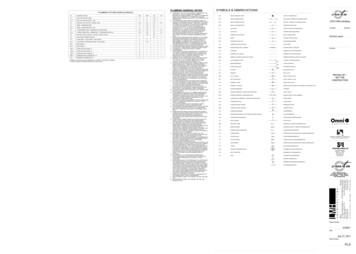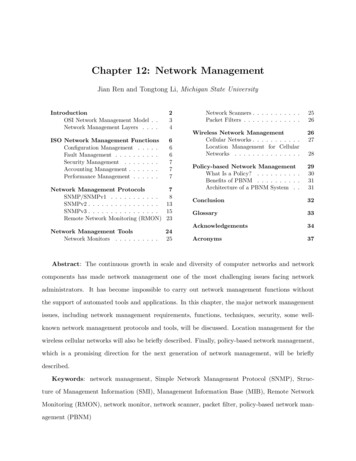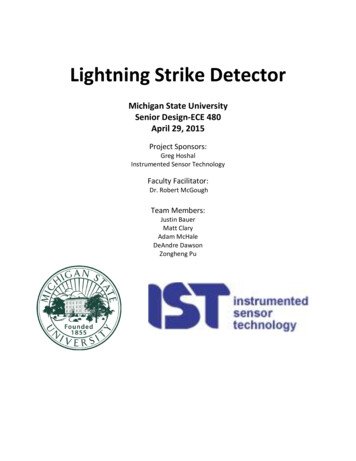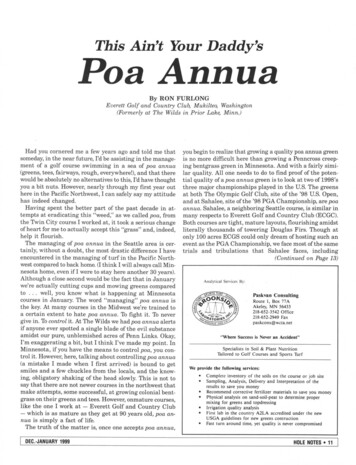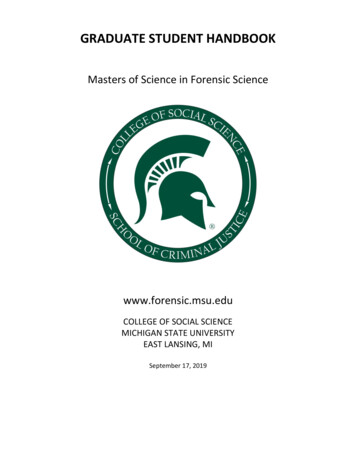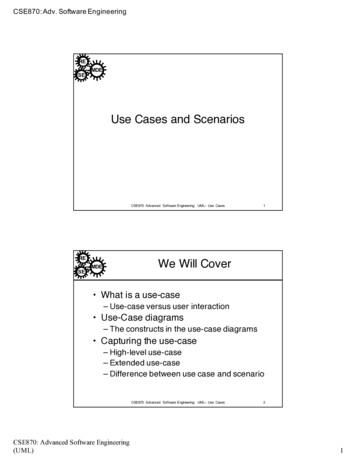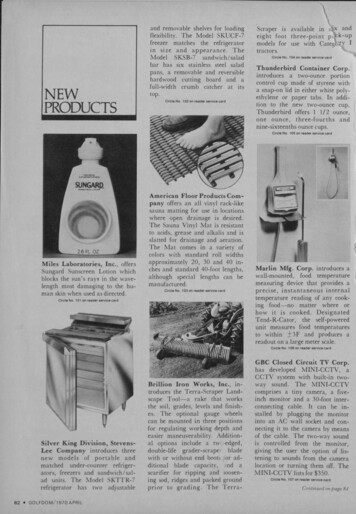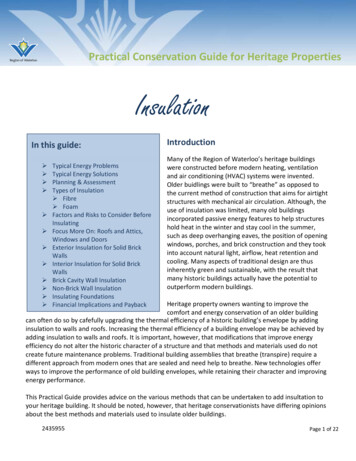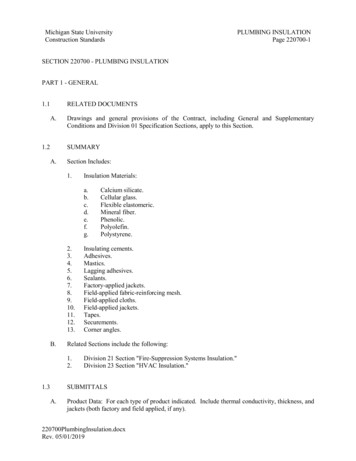
Transcription
Michigan State UniversityConstruction StandardsPLUMBING INSULATIONPage 220700-1SECTION 220700 - PLUMBING INSULATIONPART 1 - GENERAL1.1RELATED DOCUMENTSA.1.2Drawings and general provisions of the Contract, including General and SupplementaryConditions and Division 01 Specification Sections, apply to this Section.SUMMARYA.Section Includes:1.Insulation 3.B.Insulating cements.Adhesives.Mastics.Lagging adhesives.Sealants.Factory-applied jackets.Field-applied fabric-reinforcing mesh.Field-applied cloths.Field-applied jackets.Tapes.Securements.Corner angles.Related Sections include the following:1.2.1.3Calcium silicate.Cellular glass.Flexible elastomeric.Mineral fiber.Phenolic.Polyolefin.Polystyrene.Division 21 Section "Fire-Suppression Systems Insulation."Division 23 Section "HVAC Insulation."SUBMITTALSA.Product Data: For each type of product indicated. Include thermal conductivity, thickness, andjackets (both factory and field applied, if any).220700PlumbingInsulation.docxRev. 05/01/2019
Michigan State UniversityConstruction StandardsPLUMBING INSULATIONPage 220700-2B.LEED Submittal:Retain subparagraph below if low-emitting materials are required for LEED-NC Credit EQ 4.1; coordinate with requirements selected in Part 2 for adhesives and sealants.1.C.Product Data for Credit EQ 4.1: For adhesives and sealants, including printed statementof VOC content.Shop Drawings:1.2.3.4.5.6.7.8.Detail application of protective shields, saddles, and inserts at hangers for each type ofinsulation and hanger.Detail attachment and covering of heat tracing inside insulation.Detail insulation application at pipe expansion joints for each type of insulation.Detail insulation application at elbows, fittings, flanges, valves, and specialties for eachtype of insulation.Detail removable insulation at piping specialties, equipment connections, and accesspanels.Detail application of field-applied jackets.Detail application at linkages of control devices.Detail field application for each equipment type.D.Material Test Reports: From a qualified testing agency acceptable to authorities havingjurisdiction indicating, interpreting, and certifying test results for compliance of insulationmaterials, sealers, attachments, cements, and jackets, with requirements indicated. Include datesof tests and test methods employed.E.Field quality-control reports.1.4QUALITY ASSURANCEA.Installer Qualifications: Skilled mechanics who have successfully completed an apprenticeshipprogram or another craft training program certified by the Department of Labor, Bureau ofApprenticeship and Training.B.Fire-Test-Response Characteristics: Insulation and related materials shall have fire-test-responsecharacteristics indicated, as determined by testing identical products per ASTM E 84, by a testingand inspecting agency acceptable to authorities having jurisdiction. Factory label insulation andjacket materials and adhesive, mastic, tapes, and cement material containers, with appropriatemarkings of applicable testing and inspecting agency.1.2.Insulation Installed Indoors: Flame-spread index of 25 or less, and smoke-developed indexof 50 or less.Insulation Installed Outdoors: Flame-spread index of 75 or less, and smoke-developedindex of 150 or less.220700PlumbingInsulation.docxRev. 05/01/2019
Michigan State UniversityConstruction Standards1.5PLUMBING INSULATIONPage 220700-3DELIVERY, STORAGE, AND HANDLINGA.1.6Packaging: Insulation material containers shall be marked by manufacturer with appropriateASTM standard designation, type and grade, and maximum use temperature.COORDINATIONA.Coordinate size and location of supports, hangers, and insulation shields specified in Division 22Section "Hangers and Supports for Plumbing Piping and Equipment."B.Coordinate clearance requirements with piping Installer for piping insulation application andequipment Installer for equipment insulation application. Before preparing piping ShopDrawings, establish and maintain clearance requirements for installation of insulation and fieldapplied jackets and finishes and for space required for maintenance.C.Coordinate installation and testing of heat tracing.1.7SCHEDULINGA.Schedule insulation application after pressure testing systems and, where required, after installingand testing heat tracing. Insulation application may begin on segments that have satisfactory testresults.B.Complete installation and concealment of plastic materials as rapidly as possible in each area ofconstruction.PART 2 - PRODUCTS2.1INSULATION MATERIALSA.Comply with requirements in Part 3 schedule articles for where insulating materials shall beapplied.B.Products shall not contain asbestos, lead, mercury, or mercury compounds.C.Products that come in contact with stainless steel shall have a leachable chloride content of lessthan 50 ppm when tested according to ASTM C 871.D.Insulation materials for use on austenitic stainless steel shall be qualified as acceptable accordingto ASTM C 795.E.Foam insulation materials shall not use CFC or HCFC blowing agents in the manufacturingprocess.F.Calcium Silicate:1.Products: Subject to compliance with requirements, provide one of the following:220700PlumbingInsulation.docxRev. 05/01/2019
Michigan State UniversityConstruction Standardsa.2.3.4.G.Preformed Pipe Sections: Flat-, curved-, and grooved-block sections of noncombustible,inorganic, hydrous calcium silicate with a non-asbestos fibrous reinforcement. Complywith ASTM C 533, Type I.Flat-, curved-, and grooved-block sections of noncombustible, inorganic, hydrous calciumsilicate with a non-asbestos fibrous reinforcement. Comply with ASTM C 533, Type I.Prefabricated Fitting Covers: Comply with ASTM C 450 and ASTM C 585 fordimensions used in preforming insulation to cover valves, elbows, tees, and flanges.Comply withProducts: Subject to compliance with requirements, provide one of the following:a.b.Aeroflex USA Inc.; Aerocel.Armacell LLC; AP Armaflex.Mineral-Fiber Blanket Insulation: Mineral or glass fibers bonded with a thermosetting resin.Comply with ASTM C 553, Type II and ASTM C 1290, Type I. Factory-applied jacketrequirements are specified in "Factory-Applied Jackets" Article.1.Products: Subject to compliance with requirements, provide one of the following:a.b.c.d.I.Industrial Insulation Group (The); Thermo-12 Gold.Flexible Elastomeric: Closed-cell, sponge- or expanded-rubber materials.ASTM C 534, Type I for tubular materials and Type II for sheet materials.1.H.PLUMBING INSULATIONPage 220700-4CertainTeed Corp.; Duct Wrap.Johns Manville; Microlite.Knauf Insulation; Duct Wrap.Owens Corning; All-Service Duct Wrap.High-Temperature, Mineral-Fiber Blanket Insulation: Mineral or glass fibers bonded with athermosetting resin. Comply with ASTM C 553, Type V, without factory-applied jacket.1.Products: Subject to compliance with requirements, provide one of the following:a.Johns Manville; HTB 23 Spin-Glas.b.Owens Corning; High Temperature Flexible Batt Insulations.For operating temperatures higher than 250 deg F (121 deg C), use board insulation in first paragraph below. The most common jacket for equipment applications is ASJ.J.Mineral-Fiber Board Insulation: Mineral or glass fibers bonded with a thermosetting resin.Comply with ASTM C 612, Type IA or Type IB. For equipment applications, provide insulationwith factory-applied ASJ. Factory-applied jacket requirements are specified in "Factory-AppliedJackets" Article.1.Products: Subject to compliance with requirements, provide one of the following:a.b.c.d.CertainTeed Corp.; Commercial Board.Johns Manville; 800 Series Spin-Glas.Knauf Insulation; Insulation Board.Owens Corning; Fiberglas 700 Series.220700PlumbingInsulation.docxRev. 05/01/2019
Michigan State UniversityConstruction StandardsPLUMBING INSULATIONPage 220700-5For operating temperatures higher than 250 deg F (121 deg C), use high-temperature board insulation infirst paragraph below.K.High-Temperature, Mineral-Fiber Board Insulation: Mineral or glass fibers bonded with athermosetting resin. Comply with ASTM C 612, Type III, without factory-applied jacket.1.Products: Subject to compliance with requirements, provide one of the following:a.b.L.Johns Manville; 1000 Series Spin-Glas.Owens Corning; High Temperature Industrial Board Insulations.Mineral-Fiber, Preformed Pipe Insulation:1.Products: Subject to compliance with requirements, provide one of the following:a.Johns Manville; Micro-Lok.b.Knauf Insulation; 1000 Pipe Insulation.c.Owens Corning; Fiberglas Pipe Insulation.ASJ requires field-applied adhesive and staples. ASJ with SSL does not require field-applied adhesiveand staples, resulting in reduced installation labor.2.Type I, 850 deg F (454 deg C) Materials: Mineral or glass fibers bonded with athermosetting resin. Comply with ASTM C 547, Type I, Grade A, with factory-appliedASJ-SSL. Factory-applied jacket requirements are specified in "Factory-Applied Jackets"Article.Pipe and tank insulation is used for large-diameter piping and vessels. ASJ is commonly used.M.Mineral-Fiber, Pipe and Tank Insulation: Mineral or glass fibers bonded with a thermosettingresin. Semirigid board material with factory-applied ASJ jacket complying with ASTM C 1393,Type II or Type IIIA Category 2, or with properties similar to ASTM C 612, Type IB. Nominaldensity is 2.5 lb/cu. ft. (40 kg/cu. m) or more. Thermal conductivity (k-value) at 100 deg F (55deg C) is 0.29 Btu x in./h x sq. ft. x deg F (0.042 W/m x K) or less. Factory-applied jacketrequirements are specified in "Factory-Applied Jackets" Article.1.Products: Subject to compliance with requirements, provide one of the following:a.b.c.d.N.CertainTeed Corp.; CrimpWrap.Johns Manville; MicroFlex.Knauf Insulation; Pipe and Tank Insulation.Owens Corning; Fiberglas Pipe and Tank Insulation.Polyolefin: Unicellular, polyethylene thermal plastic insulation. Comply with ASTM C 534 orASTM C 1427, Type I, Grade 1 for tubular materials and Type II, Grade 1 for sheet materials.1.Products: Subject to compliance with requirements, provide one of the following:a.b.Armacell LLC; Tubolit.Nomaco Inc.; IMCOLOCK, IMCOSHEET, NOMALOCK, and NOMAPLY.220700PlumbingInsulation.docxRev. 05/01/2019
Michigan State UniversityConstruction StandardsPLUMBING INSULATIONPage 220700-6Polystyrene is for outdoor use only; its flame-spread/smoke-developed indexes are not suitable for mostindoor applications.O.Polystyrene: Rigid, extruded cellular polystyrene intended for use as thermal insulation. Complywith ASTM C 578, Type IV or Type XIII, except thermal conductivity (k-value) shall not exceed0.26 Btu x in./h x sq. ft. x deg F (0.038 W/m x K) after 180 days of aging. Fabricate shapesaccording to ASTM C 450 and ASTM C 585.1.Products: Subject to compliance with requirements, provide one of the following:a.b.Dow Chemical Company (The); Styrofoam.Knauf Insulation; Knauf Polystyrene.2.2INSULATING CEMENTSMineral-fiber insulating cement is suitable for temperatures from 100 to 1600 deg F (38 to 871 deg C).Vermiculite insulating cement is suitable for temperatures from 100 to 1800 deg F (38 to 982 deg C).A.Mineral-Fiber Insulating Cement: Comply with ASTM C 195.B.Expanded or Exfoliated Vermiculite Insulating Cement: Comply with ASTM C 196.Mineral-fiber, hydraulic-setting cement is suitable for temperatures from 100 to 1200 deg F (38 to 649deg C) and for a smooth surface.C.2.3Mineral-Fiber, Hydraulic-Setting Insulating and Finishing Cement:ASTM C 449/C 449M.Comply withADHESIVESA.Materials shall be compatible with insulation materials, jackets, and substrates and for bondinginsulation to itself and to surfaces to be insulated, unless otherwise indicated.B.Calcium Silicate Adhesive: Fibrous, sodium-silicate-based adhesive with a service temperaturerange of 50 to 800 deg F (10 to 427 deg C).Retain subparagraph below if low-emitting materials are required for LEED-NC Credit EQ 4.1.1.For indoor applications, use adhesive that has a VOC content of 80 g/L or less whencalculated according to 40 CFR 59, Subpart D (EPA Method 24).C.Cellular-Glass, Phenolic, Polyisocyanurate, and Polystyrene Adhesive: Solvent-based resinadhesive, with a service temperature range of minus 75 to plus 300 deg F (minus 59 to plus 149deg C).Retain subparagraph below if low-emitting materials are required for LEED-NC Credit EQ 4.1.1.For indoor applications, use adhesive that has a VOC content of 50 g/L or less whencalculated according to 40 CFR 59, Subpart D (EPA Method 24).220700PlumbingInsulation.docxRev. 05/01/2019
Michigan State UniversityConstruction StandardsPLUMBING INSULATIONPage 220700-7D.Flexible Elastomeric and Polyolefin Adhesive: Comply with MIL-A-24179A, Type II, Class I.Retain subparagraph below if low-emitting materials are required for LEED-NC Credit EQ 4.1.1.For indoor applications, use adhesive that has a VOC content of 50 g/L or less whencalculated according to 40 CFR 59, Subpart D (EPA Method 24).E.Mineral-Fiber Adhesive: Comply with MIL-A-3316C, Class 2, Grade A.Retain subparagraph below if low-emitting materials are required for LEED-NC Credit EQ 4.1.1.F.For indoor applications, use adhesive that has a VOC content of 80 g/L or less whencalculated according to 40 CFR 59, Subpart D (EPA Method 24).Polystyrene Adhesive: Solvent- or water-based, synthetic resin adhesive with a servicetemperature range of minus 20 to plus 140 deg F (29 to plus 60 deg C).G.ASJ Adhesive, and FSK and PVDC Jacket Adhesive: Comply with MIL-A-3316C, Class 2,Grade A for bonding insulation jacket lap seams and joints.Retain subparagraph below if low-emitting materials are required for LEED-NC Credit EQ 4.1.1.For indoor applications, use adhesive that has a VOC content of 50 g/L or less whencalculated according to 40 CFR 59, Subpart D (EPA Method 24).H.PVC Jacket Adhesive: Compatible with PVC jacket.Retain subparagraph below if low-emitting materials are required for LEED-NC Credit EQ 4.1.1.For indoor applications, use adhesive that has a VOC content of 50 g/L or less whencalculated according to 40 CFR 59, Subpart D (EPA Method 24).2.4MASTICSLEED-NC Credit EQ 4.1 does not address requirements for mastics.A.Materials shall be compatible with insulation materials, jackets, and substrates; comply with MILC-19565C, Type II.2.5LAGGING ADHESIVESLEED-NC Credit EQ 4.1 does not address requirements for lagging adhesives.A.2.6Description: Comply with MIL-A-3316C, Class I, Grade A, and shall be compatible withinsulation materials, jackets, and substrates.SEALANTSA.Joint Sealants:1.Materials shall be compatible with insulation materials, jackets, and substrates.220700PlumbingInsulation.docxRev. 05/01/2019
Michigan State UniversityConstruction StandardsPLUMBING INSULATIONPage 220700-82.Permanently flexible, elastomeric sealant.3.Service Temperature Range: Minus 100 to plus 300 deg F (Minus 73 to plus 149 deg C).4.Color: White or gray.Retain subparagraph below if low-emitting materials are required for LEED-NC Credit EQ 4.1.5.For indoor applications, use sealants that have a VOC content of 250 g/L or less whencalculated according to 40 CFR 59, Subpart D (EPA Method 24).Materials in first paragraph below are for sealing metal jacket seams and joints.B.FSK and Metal Jacket Flashing Sealants:1.Materials shall be compatible with insulation materials, jackets, and substrates.2.Fire- and water-resistant, flexible, elastomeric sealant.3.Service Temperature Range: Minus 40 to plus 250 deg F (Minus 40 to plus 121 deg C).4.Color: Aluminum.Retain subparagraph below if low-emitting materials are required for LEED-NC Credit EQ 4.1.5.For indoor applications, use sealants that have a VOC content of 250 g/L or less whencalculated according to 40 CFR 59, Subpart D (EPA Method 24).C.ASJ Flashing Sealants, and Vinyl, PVDC, and PVC Jacket Flashing Sealants:1.Materials shall be compatible with insulation materials, jackets, and substrates.2.Fire- and water-resistant, flexible, elastomeric sealant.3.Service Temperature Range: Minus 40 to plus 250 deg F (Minus 40 to plus 121 deg C).4.Color: White.Retain subparagraph below if low-emitting materials are required for LEED-NC Credit EQ 4.1.5.For indoor applications, use sealants that have a VOC content of 250 g/L or less whencalculated according to 40 CFR 59, Subpart D (EPA Method 24).2.7FACTORY-APPLIED JACKETSFor insulation materials with factory-applied jackets for use on applications above 140 deg F (60 deg C),specify sufficient insulation thickness to maintain outer surface temperature of insulation below 140 deg F(60 deg C). 140 deg F (60 deg C) surface temperature is set by OSHA for personnel protection.A.Insulation system schedules indicate factory-applied jackets on various applications. Whenfactory-applied jackets are indicated, comply with the following:1.2.3.ASJ: White, kraft-paper, fiberglass-reinforced scrim with aluminum-foil backing;complying with ASTM C 1136, Type I.ASJ-SSL: ASJ with self-sealing, pressure-sensitive, acrylic-based adhesive covered by aremovable protective strip; complying with ASTM C 1136, Type I.FSK Jacket: Aluminum-foil, fiberglass-reinforced scrim with kraft-paper backing;complying with ASTM C 1136, Type II.2.8FIELD-APPLIED JACKETSInsulation jackets in this article are for field application. ASTM C 921, Type I, is for use over insulationon equipment and pipes operating at below ambient temperatures at least part of the time or where a vapor220700PlumbingInsulation.docxRev. 05/01/2019
Michigan State UniversityConstruction StandardsPLUMBING INSULATIONPage 220700-9barrier is required. ASTM C 921, Type II, is for use over insulation on pipes operating above ambienttemperatures or where a vapor retarder is not required.A.Field-applied jackets shall comply with ASTM C 921, Type I, unless otherwise indicated.Although other thicknesses for PVC jackets are available, a flame-spread index of 25 and a smoke-developed index of 50 apply only to thicknesses of 30 mils (0.8 mm) and less.B.PVC Jacket: High-impact-resistant, UV-resistant PVC complying with ASTM D 1784,Class 16354-C; thickness as scheduled; roll stock ready for shop or field cutting and forming.Thickness is indicated in field-applied jacket schedules.1.Products: Subject to compliance with requirements, provide one of the following:a.2.3.4.Adhesive: As recommended by jacket material manufacturer.Color: White.Factory-fabricated fitting covers to match jacket if available; otherwise, field fabricate.a.5.C.Johns Manville; Zeston.Shapes: 45- and 90-degree, short- and long-radius elbows, tees, valves, flanges,unions, reducers, end caps, soil-pipe hubs, traps, mechanical joints, and P-trap andsupply covers for lavatories.Factory-fabricated tank heads and tank side panels.Metal Jacket:1.Products: Subject to compliance with requirements, provide one of the following:a.2.Childers Products, Division of ITW; Metal Jacketing Systems.Aluminum Jacket: Comply with ASTM B 209 (ASTM B 209M), Alloy 3003, 3005, 3105or 5005, Temper H-14.a.Finish and thickness are indicated in field-applied jacket schedules.Among the three moisture barriers in first subparagraph below, 1-mil (0.025-mm) barrier provides theleast protection against galvanic corrosion, 3-mil (0.075-mm) barrier offers better protection, and Polysurlyn barrier offers the best protection. For most indoor applications, 1-mil (0.025-mm) barrier is adequate. For outdoor applications, select either 3-mil (0.075-mm) or Polysurlyn barrier.b.Moisture Barrier for Indoor Applications: 1-mil- (0.025-mm-) thick, heat-bondedpolyethylene and kraft paper.c.Moisture Barrier for Outdoor Applications: 3-mil- (0.075-mm-) thick, heat-bondedpolyethylene and kraft paper.d.Factory-Fabricated Fitting Covers:1)2)3)4)Same material, finish, and thickness as jacket.Preformed 2-piece or gore, 45- and 90-degree, short- and long-radius elbows.Tee covers.Flange and union covers.220700PlumbingInsulation.docxRev. 05/01/2019
Michigan State UniversityConstruction Standards5)6)7)8)3.PLUMBING INSULATIONPage 220700-10End cap
3. Detail insulation application at pipe expansion joints for each type of insulation. 4. Detail insulation application at elbows, fittings, flanges, valves, and specialties for each type of insulation. 5. Detail removable insulation at piping specialties, equipment connections, and access p
